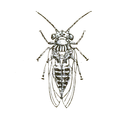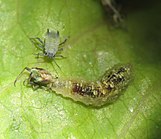Aphid
| Aphids Temporal range:
| |
|---|---|
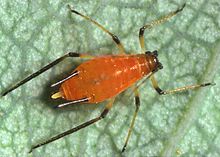
| |
| Scientific classification | |
| Domain: | Eukaryota |
| Kingdom: | Animalia |
| Phylum: | Arthropoda |
| Class: | Insecta |
| Order: | Hemiptera |
| Suborder: | Sternorrhyncha |
| Infraorder: | Aphidomorpha |
| Superfamily: | Aphidoidea Geoffroy, 1762 |
| Families | |
| |
Aphids are small sap-sucking insects and members of the superfamily Aphidoidea. Common names include greenfly and blackfly,[a] although individuals within a species can vary widely in color. The group includes the fluffy white woolly aphids. A typical life cycle involves flightless females giving live birth to female nymphs—who may also be already pregnant, an adaptation scientists call telescoping generations—without the involvement of males. Maturing rapidly, females breed profusely so that the number of these insects multiplies quickly. Winged females may develop later in the season, allowing the insects to colonize new plants. In temperate regions, a phase of sexual reproduction occurs in the autumn, with the insects often overwintering as eggs.
The life cycle of some species involves an alternation between two species of host plants, for example between an annual crop and a
Aphids are among the most destructive insect pests on cultivated plants in temperate regions. In addition to weakening the plant by sucking sap, they act as
Control of aphids is not easy.
Distribution
Aphids are
Evolution
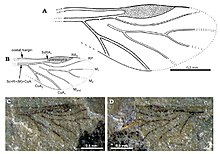
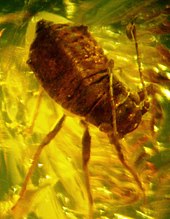
Fossil history
Aphids, and the closely related
Taxonomy
Late 20th-century reclassification within the Hemiptera reduced the old taxon "Homoptera" to two suborders:
Phylogeny
External
Aphids, adelgids, and phylloxerids are very closely related within the suborder Sternorrhyncha, the plant-sucking bugs. They are either placed in the insect superfamily Aphidoidea[18] or into the superfamily Phylloxeroidea which contains the family Adelgidae and the family Phylloxeridae.[11] Like aphids, phylloxera feed on the roots, leaves, and shoots of grape plants, but unlike aphids, do not produce honeydew or cornicle secretions.[19] Phylloxera (Daktulosphaira vitifoliae) are insects which caused the Great French Wine Blight that devastated European viticulture in the 19th century. Similarly, adelgids or woolly conifer aphids, also feed on plant phloem and are sometimes described as aphids, but are more properly classified as aphid-like insects, because they have no cauda or cornicles.[20]
The treatment of the groups especially concerning fossil groups varies greatly due to difficulties in resolving relationships. Most modern treatments include the three superfamilies, the Adelogidea, the Aphidoidea, and the Phylloxeroidea within the infraorder Aphidomorpha along with several fossil groups.[21]
| Sternorrhyncha |
| |||||||||||||||||||||||||||||||||
Internal
The phylogenetic tree, based on Papasotiropoulos 2013 and Kim 2011, with additions from Ortiz-Rivas and Martinez-Torres 2009, shows the internal
It has been suggested that the phylogeny of the aphid groups might be revealed by examining the phylogeny of their bacterial
| Aphididae | |
Anatomy

Most aphids have soft bodies, which may be green, black, brown, pink, or almost colorless. Aphids have antennae with two short, broad basal segments and up to four slender terminal segments. They have a pair of compound eyes, with an ocular tubercle behind and above each eye, made up of three lenses (called triommatidia).[11] They feed on sap using sucking mouthparts called stylets, enclosed in a sheath called a rostrum, which is formed from modifications of the mandible and maxilla of the insect mouthparts.[28]
They have long, thin legs with two-jointed, two-clawed
When host plant quality becomes poor or conditions become crowded, some aphid species produce winged offspring (alates) that can disperse to other food sources. The mouthparts or eyes can be small or missing in some species and forms.[20]
Diet

Many aphid species are monophagous (that is, they feed on only one plant species). Others, like the green peach aphid, feed on hundreds of plant species across many families. About 10% of species feed on different plants at different times of the year.[31]
A new host plant is chosen by a winged adult by using visual cues, followed by olfaction using the antennae; if the plant smells right, the next action is probing the surface upon landing. The stylus is inserted and saliva secreted, the sap is sampled, the xylem may be tasted and finally, the phloem is tested. Aphid saliva may inhibit phloem-sealing mechanisms and has pectinases that ease penetration.[32] Non-host plants can be rejected at any stage of the probe, but the transfer of viruses occurs early in the investigation process, at the time of the introduction of the saliva, so non-host plants can become infected.[31]
Aphids usually feed passively on sap of phloem vessels in plants, as do many of other hemipterans such as scale insects and cicadas. Once a phloem vessel is punctured, the sap, which is under pressure, is forced into the aphid's food canal. Occasionally, aphids also ingest xylem sap, which is a more dilute diet than phloem sap as the concentrations of sugars and amino acids are 1% of those in the phloem.[33][34] Xylem sap is under negative hydrostatic pressure and requires active sucking, suggesting an important role in aphid physiology.[35] As xylem sap ingestion has been observed following a dehydration period, aphids are thought to consume xylem sap to replenish their water balance; the consumption of the dilute sap of xylem permitting aphids to rehydrate.[36] However, recent data showed aphids consume more xylem sap than expected and they notably do so when they are not dehydrated and when their fecundity decreases. This suggests aphids, and potentially, all the phloem-sap feeding species of the order Hemiptera, consume xylem sap for reasons other than replenishing water balance.[37] Although aphids passively take in phloem sap, which is under pressure, they can also draw fluid at negative or atmospheric pressure using the cibarial-pharyngeal pump mechanism present in their head.[38]
Xylem sap consumption may be related to osmoregulation.[37] High osmotic pressure in the stomach, caused by high sucrose concentration, can lead to water transfer from the hemolymph to the stomach, thus resulting in hyperosmotic stress and eventually to the death of the insect. Aphids avoid this fate by osmoregulating through several processes. Sucrose concentration is directly reduced by assimilating sucrose toward metabolism and by synthesizing oligosaccharides from several sucrose molecules, thus reducing the solute concentration and consequently the osmotic pressure.[39][40] Oligosaccharides are then excreted through honeydew, explaining its high sugar concentrations, which can then be used by other animals such as ants. Furthermore, water is transferred from the hindgut, where osmotic pressure has already been reduced, to the stomach to dilute stomach content.[41] Eventually, aphids consume xylem sap to dilute the stomach osmotic pressure.[37] All these processes function synergetically, and enable aphids to feed on high-sucrose-concentration plant sap, as well as to adapt to varying sucrose concentrations.[37]
Plant sap is an unbalanced diet for aphids, as it lacks
Carotenoids and photoheterotrophy
Some species of aphids have acquired the ability to synthesise red
Reproduction
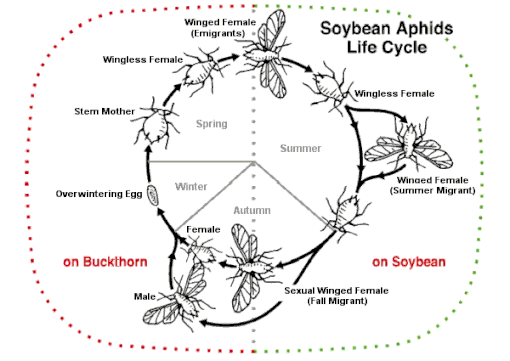
The simplest reproductive strategy is for an aphid to have a single host all year round. On this it may alternate between sexual and asexual generations (holocyclic) or alternatively, all young may be produced by parthenogenesis, eggs never being laid (anholocyclic). Some species can have both holocyclic and anholocyclic populations under different circumstances but no known aphid species reproduce solely by sexual means.[50] The alternation of sexual and asexual generations may have evolved repeatedly.[51]
However, aphid reproduction is often more complex than this and involves migration between different host plants. In about 10% of species, there is an alternation between woody (primary hosts) on which the aphids overwinter and herbaceous (secondary) host plants, where they reproduce abundantly in the summer.[20][50] A few species can produce a soldier caste, other species show extensive polyphenism under different environmental conditions and some can control the sex ratio of their offspring depending on external factors.[52]
When a typical sophisticated reproductive strategy is used, only females are present in the population at the beginning of the seasonal cycle (although a few species of aphids have been found to have both male and female sexes at this time). The overwintering eggs that hatch in the spring result in females, called fundatrices (stem mothers). Reproduction typically does not involve males (parthenogenesis) and results in a live birth (viviparity).[53] The live young are produced by pseudoplacental viviparity, which is the development of eggs, deficient in the yolk, the embryos fed by a tissue acting as a placenta. The young emerge from the mother soon after hatching.[54]
Eggs are parthenogenetically produced without
This process repeats itself throughout the summer, producing multiple generations that typically live 20 to 40 days. For example, some species of cabbage aphids (like Brevicoryne brassicae) can produce up to 41 generations of females in a season. Thus, one female hatched in spring can theoretically produce billions of descendants, were they all to survive.[58]

In autumn, aphids reproduce sexually and
Aphids reproducing asexually by

In the autumn, host-alternating (
Ecology
Ant mutualism


Some species of ants farm aphids, protecting them on the plants where they are feeding, and consuming the honeydew the aphids release from the terminations of their alimentary canals. This is a mutualistic relationship, with these dairying ants milking the aphids by stroking them with their antennae.[b][67] Although mutualistic, the feeding behaviour of aphids is altered by ant attendance. Aphids attended by ants tend to increase the production of honeydew in smaller drops with a greater concentration of amino acids.[68]
Some farming ant species gather and store the aphid eggs in their nests over the winter. In the spring, the ants carry the newly hatched aphids back to the plants. Some species of dairying ants (such as the European

An interesting variation in ant–aphid relationships involves
Another ant-mimicking gall aphid, Paracletus cimiciformis (Eriosomatinae), has evolved a complex double strategy involving two morphs of the same clone and Tetramorium ants. Aphids of the round morph cause the ants to farm them, as with many other aphids. The flat morph aphids are aggressive mimics with a "wolf in sheep's clothing" strategy: they have hydrocarbons in their cuticle that mimic those of the ants, and the ants carry them into the brood chamber of the ants' nest and raise them like ant larvae. Once there, the flat morph aphids behave like predators, drinking the body fluids of ant larvae.[71]
Bacterial endosymbiosis
Some aphid colonies also harbour secondary or facultative (optional extra) bacterial symbionts. These are vertically transmitted, and sometimes also horizontally (from one lineage to another and possibly from one species to another).[82][83] So far, the role of only some of the secondary symbionts has been described; Regiella insecticola plays a role in defining the host-plant range,[84][85] Hamiltonella defensa provides resistance to parasitoids but only when it is in turn infected by the bacteriophage APSE,[86][87] and Serratia symbiotica prevents the deleterious effects of heat.[88]
Predators
Aphids are eaten by many bird and insect predators. In a study on a farm in
Aphids are often infected by
Aphids can be easily killed by unfavourable weather, such as late spring freezes.[94] Excessive heat kills the symbiotic bacteria that some aphids depend on, which makes the aphids infertile.[95] Rain prevents winged aphids from dispersing, and knocks aphids off plants and thus kills them from the impact or by starvation,[91][96][97] but cannot be relied on for aphid control.[98]
Anti-predator defences
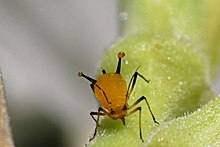
Most aphids have little protection from predators. Some species interact with plant tissues forming a gall, an abnormal swelling of plant tissue. Aphids can live inside the gall, which provides protection from predators and the elements. A number of galling aphid species are known to produce specialised "soldier" forms, sterile nymphs with defensive features which defend the gall from invasion.[28][99][100] For example, Alexander's horned aphids are a type of soldier aphid that has a hard exoskeleton and pincer-like mouthparts.[70]: 144 A woolly aphid, Colophina clematis, has first instar "soldier" nymphs that protect the aphid colony, killing larvae of ladybirds, hoverflies and the flower bug Anthocoris nemoralis by climbing on them and inserting their stylets.[101]
Although aphids cannot fly for most of their life cycle, they can escape predators and accidental ingestion by herbivores by dropping off the plant onto the ground.[102] Others species use the soil as a permanent protection, feeding on the vascular systems of roots and remaining underground all their lives. They are often attended by ants, for the honeydew they produce and are carried from plant to plant by the ants through their tunnels.[89]
Some species of aphid, known as "woolly aphids" (Eriosomatinae), excrete a "fluffy wax coating" for protection.[28] The cabbage aphid, Brevicoryne brassicae, sequesters secondary metabolites from its host, stores them and releases chemicals that produce a violent chemical reaction and strong mustard oil smell to repel predators.[103] Peptides produced by aphids, Thaumatins, are thought to provide them with resistance to some fungi.[104]
It was common at one time to suggest that the cornicles were the source of the honeydew, and this was even included in the Shorter Oxford English Dictionary[105] and the 2008 edition of the World Book Encyclopedia.[106] In fact, honeydew secretions are produced from the anus of the aphid,[107] while cornicles mostly produce defensive chemicals such as waxes. There also is evidence of cornicle wax attracting aphid predators in some cases.[108]
Some clones of Aphis craccivora are sufficiently toxic to the invasive and dominant predatory ladybird Harmonia axyridis to suppress it locally, favouring other ladybird species; the toxicity is in this case narrowly specific to the dominant predator species.[109]
Parasitoids
Aphids are abundant and widespread, and serve as hosts to a large number of parasitoids, many of them being very small (c. 0.1 inches (2.5 mm) long) parasitoid wasps.[110] One species, Aphis ruborum, for example, is host to at least 12 species of parasitoid wasps.[111] Parasitoids have been investigated intensively as biological control agents, and many are used commercially for this purpose.[112]
Plant-aphid interactions

Plants mount local and systemic defenses against aphid attack. Young leaves in some plants contain chemicals that discourage attack while the older leaves have lost this resistance, while in other plant species, resistance is acquired by older tissues and the young shoots are vulnerable. Volatile products from interplanted onions have been shown to prevent aphid attack on adjacent potato plants by encouraging the production of terpenoids, a benefit exploited in the traditional practice of companion planting, while plants neighboring infested plants showed increased root growth at the expense of the extension of aerial parts.[31] The wild potato, Solanum berthaultii, produces an aphid alarm pheromone, (E)-β-farnesene, as an allomone, a pheromone to ward off attack; it effectively repels the aphid Myzus persicae at a range of up to 3 millimetres.[113] S. berthaultii and other wild potato species have a further anti-aphid defence in the form of glandular hairs which, when broken by aphids, discharge a sticky liquid that can immobilise some 30% of the aphids infesting a plant.[114]
Plants exhibiting aphid damage can have a variety of symptoms, such as decreased growth rates, mottled leaves, yellowing, stunted growth, curled leaves, browning, wilting, low yields, and death. The removal of sap creates a lack of vigor in the plant, and aphid saliva is toxic to plants. Aphids frequently transmit

The coating of plants with honeydew can contribute to the spread of fungi which can damage plants.[117][118] Honeydew produced by aphids has been observed to reduce the effectiveness of fungicides as well.[119]
A hypothesis that insect feeding may improve plant fitness was floated in the mid-1970s by Owen and Wiegert. It was felt that the excess honeydew would nourish soil micro-organisms, including nitrogen fixers. In a nitrogen-poor environment, this could provide an advantage to an infested plant over an uninfested plant. However, this does not appear to be supported by observational evidence.[120]
Sociality
Some aphids show some of the traits of eusociality, joining insects such as ants, bees, and termites. However, there are differences between these sexual social insects and the clonal aphids, which are all descended from a single female parthenogenetically and share an identical genome. About fifty species of aphid, scattered among the closely related, host-alternating lineages Eriosomatinae and Hormaphidinae, have some type of defensive morph. These are gall-creating species, with the colony living and feeding inside a gall that they form in the host's tissues. Among the clonal population of these aphids, there may be several distinct morphs and this lays the foundation for a possible specialization of function, in this case, a defensive caste. The soldier morphs are mostly first and second instars with the third instar being involved in Eriosoma moriokense and only in Smythurodes betae are adult soldiers known. The hind legs of soldiers are clawed, heavily sclerotized and the stylets are robust making it possible to rupture and crush small predators.[121] The larval soldiers are altruistic individuals, unable to advance to breeding adults but acting permanently in the interests of the colony. Another requirement for the development of sociality is provided by the gall, a colonial home to be defended by the soldiers.[122]
The soldiers of gall-forming aphids also carry out the job of cleaning the gall. The honeydew secreted by the aphids is coated in a powdery wax to form "liquid marbles"[123] that the soldiers roll out of the gall through small orifices.[100] Aphids that form closed galls use the plant's vascular system for their plumbing: the inner surfaces of the galls are highly absorbent and wastes are absorbed and carried away by the plant.[100]
Interactions with humans
Pest status
About 5000 species of aphid have been described and of these, some 450 species have colonized food and fiber crops. As direct feeders on plant sap, they damage crops and reduce yields, but they have a greater impact by being
Aphids, especially during large outbreaks, have been known to trigger allergic inhalant reactions in sensitive humans.[126]
Dispersal can be by walking or flight, appetitive dispersal, or by migration. Winged aphids are weak fliers, lose their wings after a few days and only fly by day. Dispersal by flight is affected by the impact, air currents, gravity, precipitation, and other factors, or dispersal may be accidental, caused by the movement of plant materials, animals, farm machinery, vehicles, or aircraft.[124]
Control
For small backyard infestations, spraying plants thoroughly with a strong water jet every few days may be sufficient protection. An insecticidal soap solution can be an effective household remedy to control aphids, but it only kills aphids on contact and has no residual effect. Soap spray may damage plants, especially at higher concentrations or at temperatures above 32 °C (90 °F); some plant species are sensitive to soap sprays.[112][128][129]
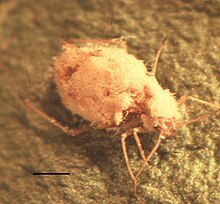
Aphid populations can be sampled using yellow-pan or Moericke traps. These are yellow containers with water that attract aphids.[130] Aphids respond positively to green and their attraction to yellow may not be a true colour preference but related to brightness. Their visual receptors peak in sensitivity from 440 to 480 nm and are insensitive in the red region. Moericke found that aphids avoided landing on white coverings placed on soil and were repelled even more by shiny aluminium surfaces.[131] Integrated pest management of various species of aphids can be achieved using biological insecticides based on fungi such as Lecanicillium lecanii, Beauveria bassiana or Isaria fumosorosea.[132] Fungi are the main pathogens of aphids; Entomophthorales can quickly cut aphid numbers in nature.[133]
Aphids may also be
The ability to produce allomones such as
In human culture
Aphids are familiar to farmers and gardeners, mainly as pests.
Infestation of the Chinese sumac (Rhus chinensis) by Chinese sumac aphids (Schlechtendalia chinensis) can create "Chinese galls" which are valued as a commercial product. As "Galla Chinensis", they are used in traditional Chinese medicine to treat coughs, diarrhea, night sweats, dysentery and to stop intestinal and uterine bleeding. Chinese galls are also an important source of tannins.[28]
See also
- Aeroplankton
- Economic entomology
- Pineapple gall
Notes
- Simuliidae, among them the vector of river blindness.
- ^ Dairying ants also milk mealybugs and other insects.
References
- ISBN 978-0-313-33922-6.
- ^ PMID 28445493.
- JSTOR 3084.
- .
- ^ Hill, L. (2012). "The currant lettuce aphid, Nasonovia ribisnigri arrives in Tasmania: Part 1". Victorian Entomologist. 42 (2): 29–31.
- PMID 19432979.
- .
- ^ ISBN 978-1-4020-6242-1. Archivedfrom the original on 2020-08-05. Retrieved 2018-02-04.
- (PDF) from the original on 2012-09-27. Retrieved 2010-10-18.
- . Retrieved 2018-02-04.
- ^ ISBN 978-0-412-74180-7. Archivedfrom the original on 2013-02-18. Retrieved 2016-05-24.
- .
- S2CID 86517289.
- ^ Gullan, Penny J.; Martin, Jon H. (2009). "Sternorrhyncha". Encyclopedia of Insects (2nd ed.).
- ^ Rohdendorf, B. B., ed. (1991). Fundamentals of Paleontology. Volume 9. Arthropoda, Tracheata, Chelicerata. Smithsonian Institution and National Science Foundation. pp. 267–274.
- ^ Sorensen, J. T. (2009). "Aphids". In Resh, Vincent H.; Cardé, R. T. (eds.). Encyclopedia of Insects (2 ed.). Academic Press. pp. 27–31.
- ^ "Superfamily Aphidoidea, Latreille, 1802". Aphid: species file. Archived from the original on 6 November 2017. Retrieved 3 February 2018.
- ISBN 978-0-85198-877-1.
- PMID 11112174.
- ^ ISBN 978-0-8160-2737-8.
- ^ Favret, C.; Eades, D.C. (2020). Miller, G.L.; Qiao, G.; Sano, Masakazu; Stekolshchikov, A.V. (eds.). "Aphid Species File - Aphidomorpha". Université de Montréal. aphid.speciesfile.org. Montreal, Canada: Aphid Species File. Archived from the original on February 24, 2021. Retrieved December 13, 2020.
- ^ Papasotiropoulos, Vassilis; Tsiamis, Georgios; Papaioannou, Charikleia; Kilias, George (2013). "A molecular phylogenetic study of aphids (Hemiptera: Aphididae) based on mitochondrial DNA sequence analysis". Journal of Biological Research-Thessaloniki. 20: 1–13. Archived from the original on 2018-01-16. Retrieved 2018-01-15.
- PMID 21935453.
- PMID 20004730.
- PMID 10937228.
- (PDF) from the original on 2017-08-10. Retrieved 2018-04-27.
- PMID 28860659.
- ^ ISBN 978-0-07-911504-1.
- ^ Mutti, Navdeep S. (2006). Molecular Studies of the Salivary Glands of the Pea Aphid, Acyrthosiphon pisum (Harris) (PDF) (Ph.D. thesis). Kansas State University. Archived (PDF) from the original on 2012-02-27. Retrieved 2008-07-12.
- PMID 25972400.
- ^ ISBN 978-1-78064-709-8.
- PMID 16332214.
- .
- ^ ISBN 978-0-943088-39-6.
- JSTOR 2588576.
- .
- ^ PMID 20036244. Archived from the original(PDF) on 16 July 2011.
- ^ Kingsolver, J. G.; Daniel, T. L. (1995). "Mechanics of Food Handling by Fluid-Feeding Insects". In Chapman, R. F.; de Boer, Gerrit (eds.). Regulatory mechanisms in insect feeding. Springer. pp. 60–65.
- PMID 12770238.
- from the original on 2008-08-21. Retrieved 2010-10-18.
- PMID 18983920.
- PMID 5827534.
- ISBN 978-0-470-11517-6.
- .
- .
- S2CID 14785276.
- PMID 21920958.
- PMID 22900140.
- ^ a b Wang, C. L.; Siang, L. Y.; Chang, G. S.; Chu, H. F. (1962). "Studies on the soybean aphid, Aphis glycines Matsumura". Acta Entomologica Sinica. 11: 31–44.
- ^ ISBN 978-1-78064-709-8. Archivedfrom the original on 2021-06-24. Retrieved 2018-04-29.
- .
- .
- ^ .
- ^ ISBN 978-1-118-84615-5.
- ^ S2CID 25605477.
- S2CID 25758038.
- S2CID 1941852. Archived from the original(PDF) on 2010-09-09.
- JSTOR 2600.
- PMID 20083636.
- PMID 23472179.
- ISSN 0022-1910.
- ISSN 1461-023X.
- PMID 19439653.
- OCLC 872604083.
- PMID 30629747.
- ISBN 978-1-4822-5421-1. Archivedfrom the original on 2021-06-24. Retrieved 2018-02-03.
- ^ ISBN 978-0-7166-0108-1.
- .
- ISBN 978-0-7137-2366-3.
- ^ ISBN 978-0-8094-9687-7.
- PMID 25583474.
- ISBN 978-0-387-25476-0.
- PMID 15012383.
- PMID 22575468.
- from the original on 2021-11-13. Retrieved 2020-11-16.
- PMID 24086359.
- S2CID 40081627.
- S2CID 33681686.
- PMID 10993077.
- PMID 17547756.
- PMID 15937185.
- S2CID 24144752.
- PMID 16000822.
- S2CID 37052892.
- PMID 12964998.
- ISBN 9783319280660.
- PMID 23193123.
- PMID 16720402.
- ^ ISBN 978-1-4443-5784-4.
- ISBN 978-1-78064-709-8.
- ^ a b c Brust, Gerald E. (22 June 2006). "Early season aphid and thrips populations". University of Maryland, College Park. Archived from the original on 19 July 2011. Retrieved 18 October 2010.
- JSTOR 1933502.
- JSTOR 2402724.
- ^ Krupke, Christian; Obermeyer, John; O'Neil, Robert (2007). "Soybean aphid, a new beginning for 2007". Pest and Crop. 7. Purdue University. Archived from the original on 2021-02-04. Retrieved 2008-07-17.
- Science Daily. 23 April 2007. Archivedfrom the original on 15 January 2018. Retrieved 28 February 2018.
- JSTOR 2600.
- ^ Suwanbutr, S. (1996). "Stable age distributions of lucerne aphid populations in SE-Tasmania" (PDF). Thammasat International Journal of Science and Technology. 1 (5): 38–43. Archived from the original (PDF) on 10 September 2008.
- ^ Ostlie, Ken (3 August 2006). "Spider Mites, Aphids and Rain Complicating Spray Decisions in Soybean" (PDF). Minnesota Crop eNews. University of Minnesota. Archived from the original (PDF) on 10 September 2008.
- ^ Aoki, S. (1977). "Colophina clematis (Homoptera, Pemphigidae), an aphid species with soldiers" (PDF). Japanese Journal of Entomology. 45 (2): 276–282.[permanent dead link]
- ^ PMID 23149732.
- ISBN 978-0-262-16137-4.
- PMID 22496734.
- PMID 17623639.
- ^ Vilcinskas, Andreas (2016). "Aphid Immunity.". Biology and Ecology of Aphids. CRC Press. p. 131.
- S2CID 4295930.
- ISBN 978-0-7166-0108-1.
- .
- S2CID 25298742.
- PMID 29848647.
- ^ "Aphid Parasitoids". IET Department of the College of Agriculture and Natural Resources. extension.umd.edu. College Park, Maryland: University of Maryland. Archived from the original on 2018-06-26. Retrieved 2018-04-29 – via College of Agriculture & Natural Sciences.
Aphid parasitoids are very tiny wasps, about 1/10 inch long. They are slender, black or brown, and have a pinched or "wasp waist"
- S2CID 84348019.
- ^ a b c Flint, M.L. (July 2013). "Aphids". UC IPM. Archived from the original on 2018-04-09. Retrieved 6 February 2018.
- S2CID 4345998.
- .
- ^ Nalam, Vamsi. "Plant defense against aphids, the pest extraordinaire". ScienceDirect. Plant Science. Retrieved 16 March 2024.
- ^ United States Department of Agriculture (2003). Studies on the Chemical and Biological Properties of Coumestrol and Related Compounds. US Government Printing Office. pp. 47–67. Archived from the original on 2015-04-02. Retrieved 2015-04-26.
- ^ Gillman, Daniel H. (2005). "Sooty mold" (PDF). University of Massachusetts Amherst. Archived (PDF) from the original on September 28, 2011. Retrieved October 18, 2010.
- ^ Reynolds, Hannah T.; Volk, Tom (September 2007). "Scorias spongiosa, the beech aphid poop-eater". Tom Volk's Fungus of the Month. University of Wisconsin–La Crosse. Archived from the original on July 30, 2010. Retrieved October 18, 2010.
- .
- JSTOR 3565718.
- S2CID 8991755.
- ISBN 978-0-521-58977-2.)
{{cite book}}: CS1 maint: multiple names: authors list (link - PMID 12065036.
- ^ ISBN 978-1-78064-709-8.
- ^ Cloyd, Raymond (14 February 2022). "Aphids". Greenhouse Product News. 32: 14.
- .
- ^ Pundt, Leanne (2011). "Managing Aphids in the Greenhouse". University of Connecticut College of Agriculture, Health, and Natural Resources. Archived from the original on 2018-02-18. Retrieved 20 February 2018.
- ^ Cranshaw, W.S. (March 2008). "Insect Control: Soaps and Detergents". University of Colorado. Archived from the original on 7 February 2018. Retrieved 6 February 2018.
- ^ Ubl, J.B. (July 2009). "Insecticidal Soaps for Garden Pest Control". Clemson University. Archived from the original on 22 January 2018. Retrieved 6 February 2018.
- from the original on 2021-11-13. Retrieved 2020-03-22.
- (PDF) from the original on 2020-09-19. Retrieved 2020-08-27.
- )
- PMID 16780867.
- ^ Lady Beetle Releases for Aphid Control: How to Help Them Work Archived 2015-04-02 at the Wayback Machine. Clark, J.K., University of California Davis, June 2011.
- PMID 16798877.
- .
- ISBN 978-0-7011-8180-2. Archivedfrom the original on 2017-03-14. Retrieved 2018-02-09.
External links
- Aphids of southeastern U.S. woody ornamentals
- Acyrthosiphon pisum, MetaPathogen – facts, life cycle, life cycle image
- Sequenced Genome of Pea Aphid, Agricultural Research Service
- Insect Olfaction of Plant Odour: Colorado Potato Beetle and Aphid Studies
- Asian woolly hackberry aphid, Center for Invasive Species Research
On the University of Florida / Institute of Food and Agricultural Sciences Featured Creatures website:
- Aphis gossypii, melon or cotton aphid
- Aphis nerii, oleander aphid
- Hyadaphis coriandri, coriander aphid
- Longistigma caryae, giant bark aphid
- Myzus persicae, green peach aphid
- Sarucallis kahawaluokalani, crapemyrtle aphid
- Shivaphis celti, an Asian woolly hackberry aphid
- Toxoptera citricida, brown citrus aphid

